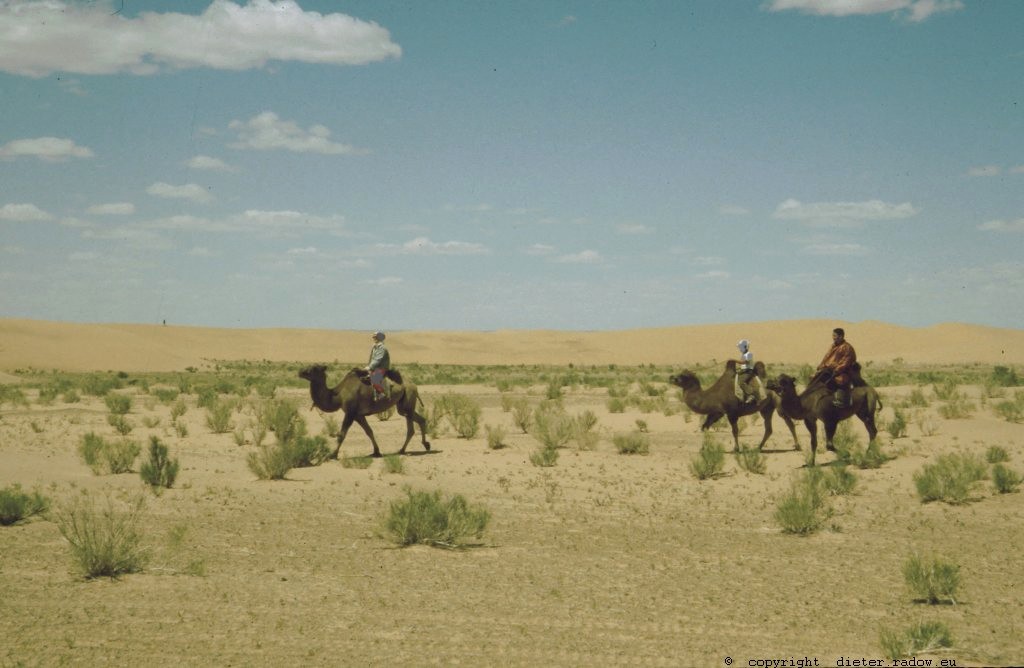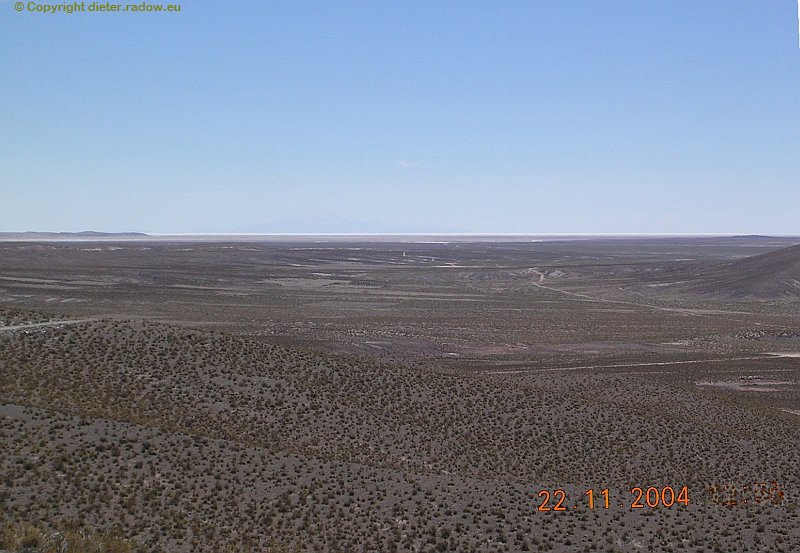Steppes
Steppes fascinate by rambling naturalness, only just enough to exist, a contrary to menkind threatening utilization of land for farming, building and mega cities.
Steppe is a land form outside the tropics, shaped of grass or steppe-heather, sparse of bush and trees. Suitability for agriculture depends of soil, climate, and rainfall. Generally the steppe-climate is characterized by continental high- pres- sure weather conditions with hot, dry summer and cold winter. Widespread steppes allow an extensive pastural far- ming, sometimes even arable agriculture, used alternating one year livestock-grassing, one year arable farming. Soil of steppes is solid for the most part, containing loam or clay. Poor vegetation cannot contribute much to mould humus. Soil and climate determine the kind of exploitation and products. On poorest soil goats may get on. Then sheep- and perhaps donkey-, seldom cattle-farming may be possible, Horse herds I watched on Mongolian steppes. -
In transitional zones to desserts steppes may look like desserts, if sand from there has been blown along. Savanas, even their dry zones are not counted to the steppes, though we find there same or similar manifestations. But between the tropics there is another climate, more (alternating) humidity and there are no cold winters. Therefore the vegetation is another than in the steppes
° ° ° ° °
Faszinieren durch Weite und Naturbelassenheit. Ebennoch-Lebensraum und Gegensatz zur menschheitsbedrohenden allgegenwärtigen Natur-Zersiedlung
Steppen sind eine baumarme Landschaftsform außerhalb der Tropen, die meist durch Gras oder Steppenheide geprägt wird. Die Eignung für die Landwirtschaft hängt von den Böden, dem Klima und den Niederschlägen ab. Generell zeich- net sich das Steppenklima durch kontinentales Hochdruckwetter mit heißen niederschlagsarmen Sommern und kalten Wintern aus. Vielfach ist eine extensive Viehweidung, vereinzelt auch Ackerbau als Steppenwechselwirtschaft (ein Jahr Weide, ein Jahr Acker) möglich. Der Boden ist häufig fest, Lehm- Ton-, Kleie-geprägt. Eine geringe Vegetation kann nur wenig zur Humusbildung beitragen. Von Boden und Klima hängen auch die Arten einer möglichen Nutzung ab. Die ärmsten Böden gestatten vielleicht Ziegenhaltung, als nächstes kommen Schafe, schließlich Esel, kaum jemals Rinder in Betracht. Pferdeherden in freier Zucht habe ich in mongolischen Steppen beobachtet. - In den Übergangszonen zu Wüsten nimmt das Steppengelände durch angeflogenen Sand manchmal das Aussehen einer Wüste an. – Sawannen, auch Trockensavannen werden trotz Gleichheit mancher Erscheinungsmerkmale nicht zu den Steppen gerechnet. Zwischen den Tropen herrscht ein anderes, wechselfeuchtes Klima und es fehlen strenge Winter. Daher treffen wir dort eine andere Vegetation an.
° ° ° ° °
ASIEN – ASIA
UZBEKISTAN - USBEKISTAN

Uzbekistan 1998 – Karalpakstan, camels to the water-well,
Usbekistan 1998 – Karalpakstan, Kamele ziehen zur Wasserstelle

Usbekistan 2000 – Karalpakstan: Gebirgssteppe des Sultan Uvays Höhenrücken
Uzbekistan 2000 – Karakal Pakstan: mountain-steppe of the Sultan Uvays range
Usbekistan 1998 – Turan Wechselweidewirtschaft – ErdnüsseUzbekistan 1998 – agrculture in turn (this year groundnuts, next year pasturalagriculture)

Usbekistan 1998 – Karshinskaja-Steppe: Weidewirtschaft – asiatisches Breitschwanz-Schaf
Uzbekistan 1998 – Karshinskaja-steppe: pastural agriculture – broad-tail caracul sheep

Usbekistan 2000 – Karalpakstan Region Ashitay: Burg Toprak Kala in der Gebirgssteppe des Sultan Uvays Höhenrücken
Uzbekistan 2000 – Karakal Pakstan region Ashitay: castle Toprak Kala in the mountain-steppe of the Sultan Uvays range
IRAN – IRAN

Iran 1999 – Hamedan-Region: Steppenweidewirtschaft (hinten: zoroastrischer Feuertempel)
Iran 1999 – Hamedan-region: pastural steppe-agriculture (in the middle of the picture: zoroastric fire temple)
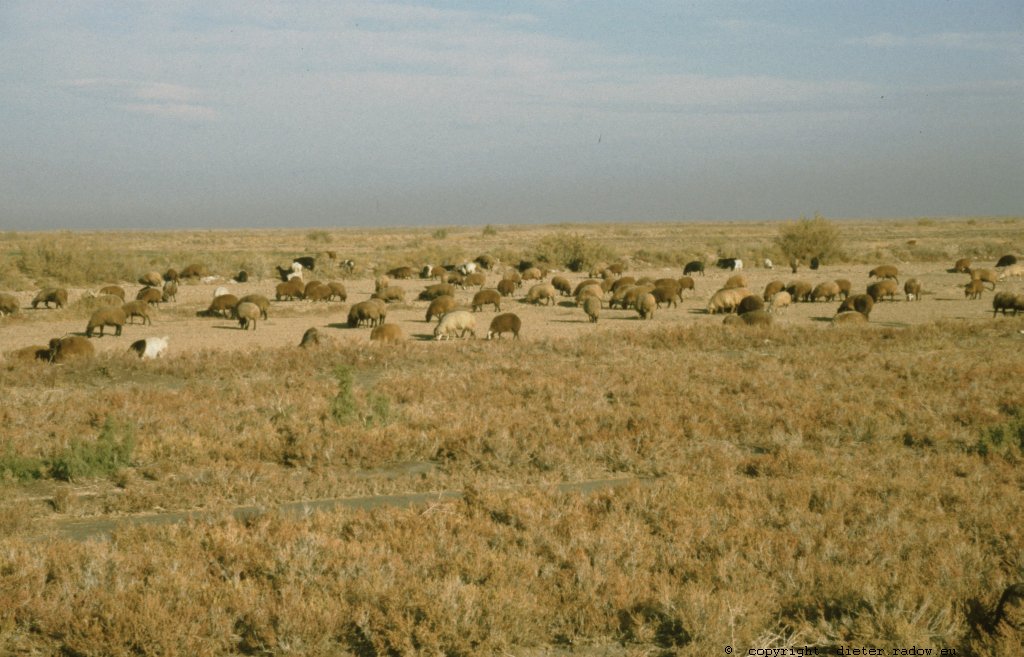
Iran 1999 – Khorasan südliche Steppe: Weidewirtschaft
Iran 1999 – Khorasan southern Steppe: pastural agriculture

Iran 1999 – Khorasan südliche Steppe: Wechseleidewirtschaft
Iran 1999 – Khorasan southern Steppe: alternating (pastural and arable) farming

Iran 1999 – Khorasan südliche Steppe: Weidewirtschaft
Iran 1999 – Khorasan southern Steppe: pastural agriculture

Iran 1999 – Khorasan südliche Steppe: hier: früchtetragende wilde Büpsche; im übrigen: Weidewirtschaft
Iran 1999 – Khorasan southern Steppe with fruit bearing shrub. Otherwise: pastural agriculture

Iran 1999 – Khorasan – Steppennomaden (Ziegen-Schaf-Esel Haltung)
Iran 1999 – Khorasan – steppe-nomad-tent (goat-sheep-and ass owning in pastoral agriculture
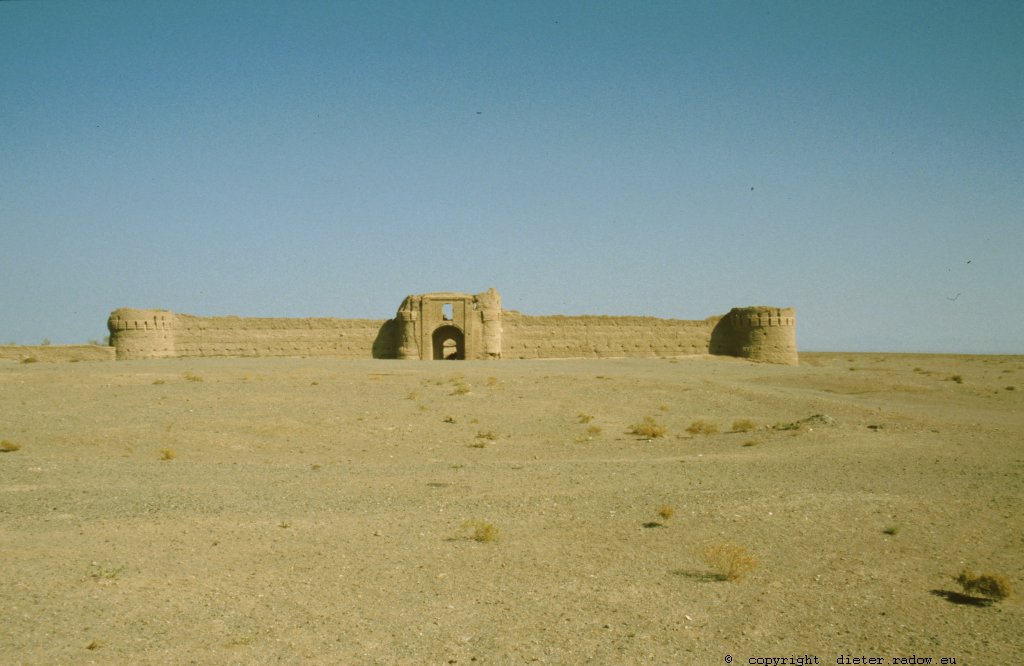
Iran 1999 – Khorasan – Karawanserei in der Steppe zwischen Meshad und Mary
Iran 1999 – Khorasan – caravan station in the steppe between Meshad and Mary

Iran 1999 – Khorasan südliche Steppe: Wechselweidewirtschaft
Iran 1999 – Khorasan Southern Steppe: alternating agriculture
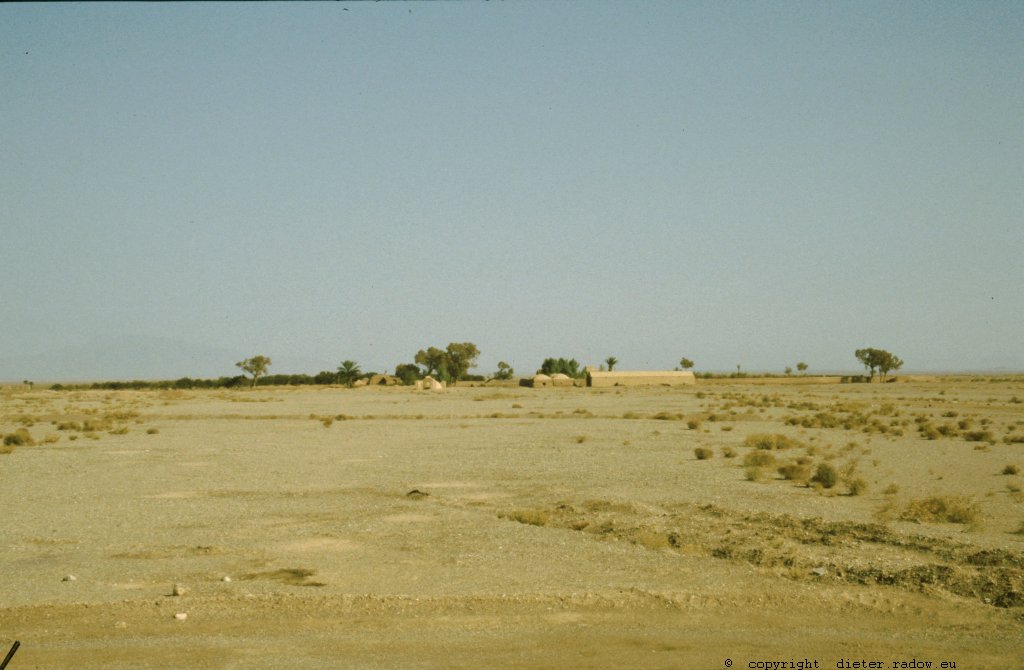
Iran 1999 – Khorasan südliche Steppe: kleines Gehöft für Steppenwechselwirtschaft
Iran 1999 – Khorasan southern steppe: farmstead with alternating agriculture

Iran 1999 – Khorasan südliche Steppe: alte Karavanserei; heute benutzt als Stall für die Transport-Kamele
Iran 1999 – Khorasan southern steppe: old caravan station; nowadays used as stable for the transport-camels

Iran 1999 – Khorasan südliche Steppe: Mitte: alte Karavanserei; im Hintergrund der Gebirgszug Kopegdag (Grenze zu Turkmenistan)
Iran 1999 – Khorasan southern steppe: in the middle: old caravan station; in the background the mountain-range Kopeq-Daq with border to Turkmenistan

Iran 1999 – Khorasan: Reste der doppelten Mauer einer Fluchtburg der Steppenvölker für Menschen und Tiere vor durchziehenden Heeren oder Banden
Iran 1999 – Khorasan: wall of an old refuge for men and animals of the steppe-nomads against attacks of passing troups or other bunchs

Iran 1999 – Khorasan – Karawanserei in der Steppe zwischen Meshad und Mary
Iran 1999 – Khorasan – caravan station in the steppe between Mashad and Mary
Iran 1999 – Khorasan: Reste der Mauer einer Fluchtburg der Steppenvölker für Menschen und Tiere vor durchziehenden Heeren oder Banden
Iran 1999 – Khorasan: wall of an old refuge for men and animals of the steppe-nomads against attacks of passing troups or other bunchs

Iran 1999 – Khorasan: Karavanserei an der Strecke Meschad-Merv, heute von seßhaften Steppenbewohnern als Bauernghöft verwendet
Iran 1999 – Khorasan: Caravan-station at the route Meshad-Mary (Turkmenistan), nowadays used by settled steppe-farmers
TURKMENISTAN – TURKMENISTAN

Turkmenistan 2000 – Steppenlandschaft mit Resten der antiken Stadt Nissa, der Hauptstadt des alten Parther-Reiches
Turkmenistan 2000 – steppe-land around the remainings of the anciant city of Nissa, the residence of the Pathian Kingdom
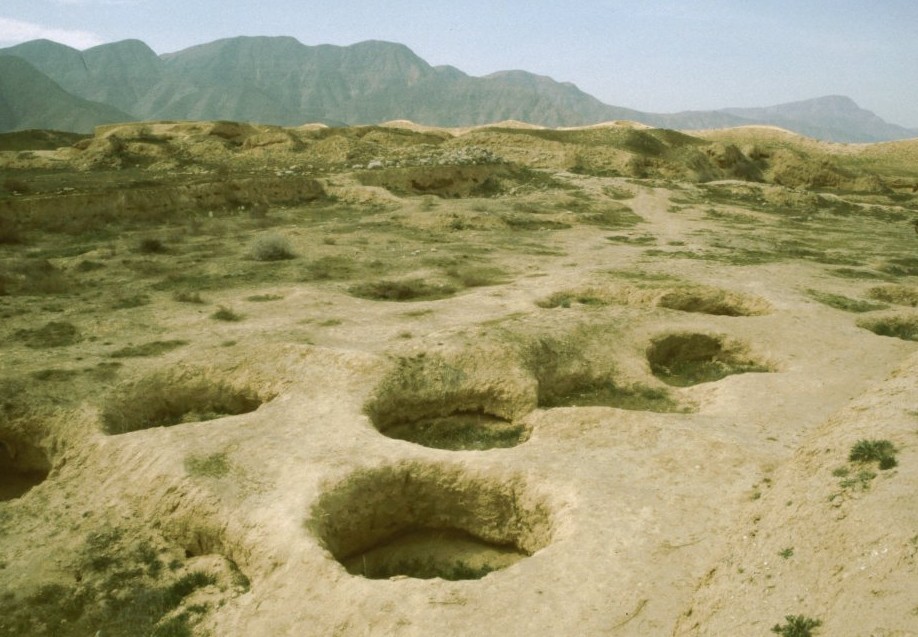
Turkmenistan 2000 – Steppenlandschaft mit Resten einer alten Nekropole bei der antiken Stadt Nissa, der Hauptstadt des alten Parther-Reiches
Turkmenistan 2000 – remainings of an old nekropolis near the anciant city of Nissa, the residence of the Parthian Kingdom. The soil seems typical for steppes landforms
Turkmenistan 2000 – Steppe als Übergang zur nördlich gelegenen Wüste Karakum mit dichter Ginster-Vegetation
Turkmenistan 2000 – steppe south of the dessert Karakoum with broom or broom-like vegetation
Turkmenistan 2000 – Wüste Karakum nördlich Mary; im Übergangsgebiet handelt es sich noch um Steppe
Turkmenistan 2000 – Central Dessert Garagum north of Mary; the transitional area has the character of a steppe
Turkmenistan 2000 – Wüste Karakum nördlich Mary: Fluchtburg
Turkmenistan 2000 – Central dessert Garagum north of Mary: refuge
Turkmenistan 2000 – Wüste Karakum nördlich Mary: Ruinen einer großen alten Fluchtburg für Mensch und Vieh
Turkmenistan 2000 – Central dessert Garagum north of Mary: remains of a large old refuge for men and animals
Turkmenistan 2000 – Wüste Karakum nördlich Mary; – bei freier Weidewirtschaft m Übergangsgebiet wechseln die Kamele zwischen Wüste und Steppe
Turkmenistan 2000 – Central Dessert Garagum north of Mary; in the transitional areathe camels change bewetween steppe and dessert
TADSCHIKISTAN – TAJIKISTAN

- Tadschikistan 1998 – Reste der antiken sogdischen Stadt Pendischkent in Steppenlandschaft
Tajikistan 1998 – ruins of the ancient Sogdian town Pangakent in the steppe
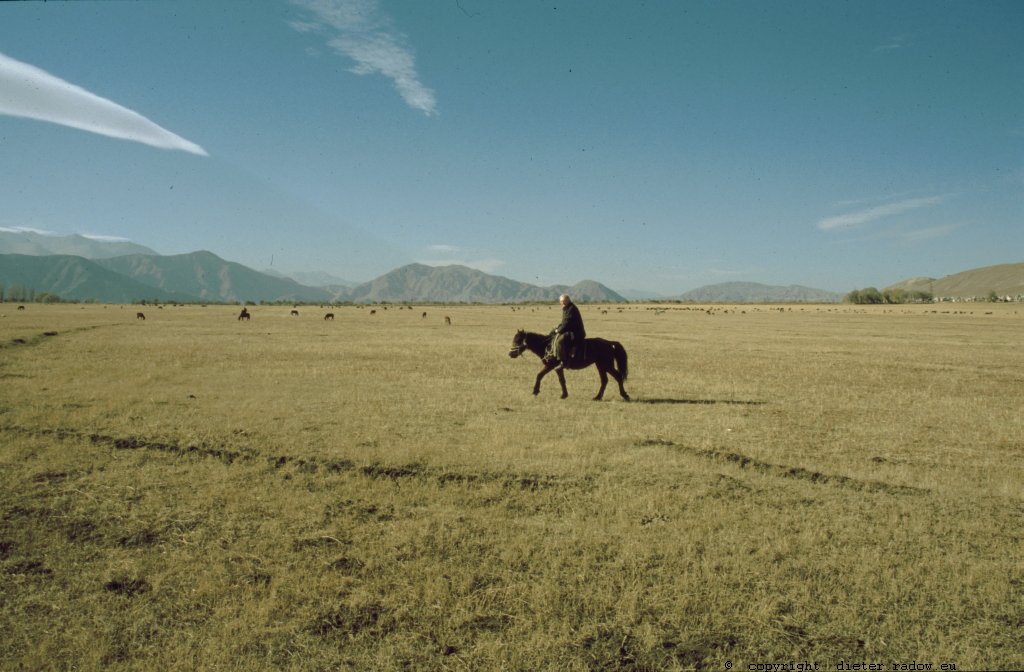
Kirgistan 1998 – Yssik-Kul-Region , Reiter in der zentralasiatischen Steppe Kirgistans
Kirghizia 1998 – Yssik-Kul-region , horseman in the Central Asian steppe of Kirghizia
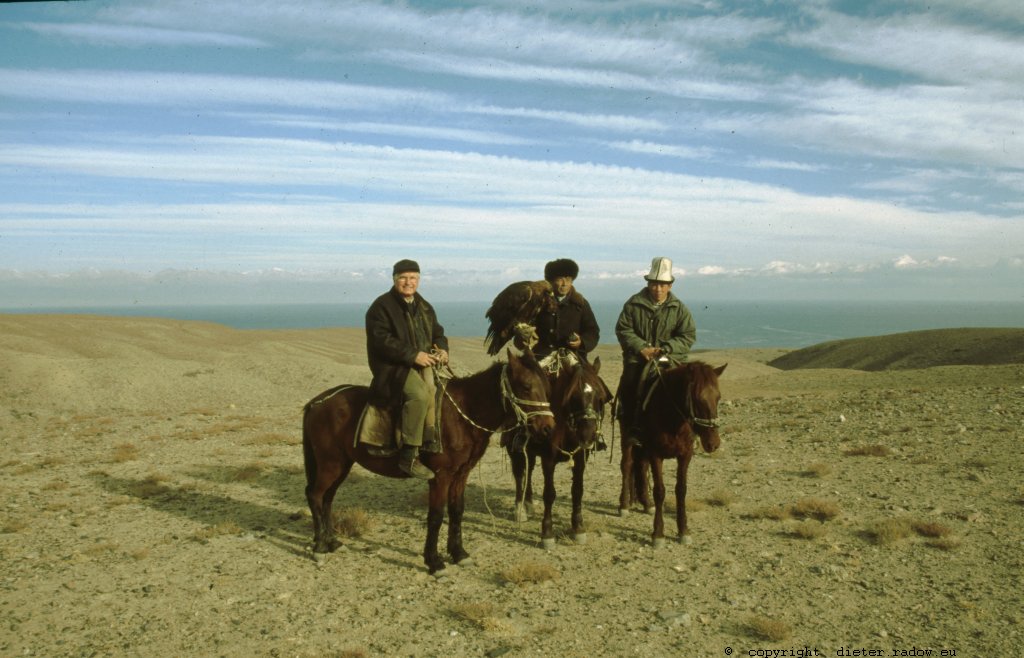
Kirgistan 1998 – am Yssik-Kul-See: Falknerjagd mit zentralasiatischem Steppenadler
Kirghizia 1998 – Lake Yssyk-Köl : hawking with Central-Asian-Steppes-Eagle

Kirgistan 1998 – fruchtbare Steppe am nördlichen Rand desYssik-Kul-Sees: – hier zogen Jahrtausende Vieh-Karawanen und Reitertruppen hindurch
Kirghizia 1998 – rich steppe at the Lake Yssyk-Köl : thousands of years caravans and troops of horses passed here

Kirgistan 1998 – fruchtbare Steppe am nördlichen Rand desYssik-Kul-Sees: – hier zogen Jahrtausende Vieh-Karawanen und Reitertruppen hindurch
Kirghizia 1998 – rich steppe at the Lake Yssyk-Köl : thousands of years caravans and troops of horses passed here

Kirgistan 1998 – fruchtbare Steppe am nördlichen Rand desYssik-Kul-Sees: – hier zogen Jahrtausende Vieh-Karawanen und Reitertruppen hindurch
Kirghizia 1998 – rich steppe at the Lake Yssyk-Köl : thousands of years caravans and troops of horses passed here

Kirgistan 1998 – fruchtbare Steppe am nörd-östlichen Rand desYssik-Kul-Sees: Nomadentum wurde unter den Sowjets abgeschafft. Heute treffen sich die Nachkommen der Steppennomaden mitten im Steppengelände zu einem Erinnerungs-Umtrunk
Kirghizia 1998 – rich steppe at the North-East side ofLake Yssyk-Köl : nomadism has been done away by the Sovjets. Nowadays the descendants of the steppes-nomads meat in the steppe for a commemorative drink.

Kirgistan 1998 – Yssik-Kul-Region , Reiter in der zentralasiatischen Gebirgs-Steppe Kirgistans
Kirghizia 1998 – Yssik-Kul-region , horseman in the Central Asian mountain-steppe of Kirghizia

Kirgistan 1998 - Burana-Turm einer früheren Karawanserei, wo mehrere Routen der Seidenstraße sich zu den Randsteppen des Issik-Kul Sees verzweigten :
Kirghizia 1998 – Burana-Tower of an old caravan station, junction of different routes of the silk-road through steppes at the Lake Yssyk-Köl and in the West
MONGOLEI – MONGOLIA

Mongolei 2002 – Rinderherde bei Flußquerung – Flüsse sind untypisch für die Steppe; das Wasser kommt aus den angrenzenden Gebirgen
Mongolia 2002 – cattle-herd crossing a river – Rivers are atypical for steppes. The water comes from mountains outside.

Mongolei 2002 – Schafherde vor Flußquerung – Flüsse sind untypisch für die Steppe; das Wasser kommt aus den angrenzenden Gebirgen
Mongolia 2002 – flock of sheep has to cross the river – Rivers are atypical for steppes. The water comes from mountains outside.

Mongolei 2002 – Steppenhirten zu Pferde
Mongolia 2002 – steppe-herdsmen on horseback

Mongolei 2002 – Steppenhirten zu Pferde treiben eine Schafherde
Mongolia 2002 – steppe-herdsmen on horseback driving a flock of sheep
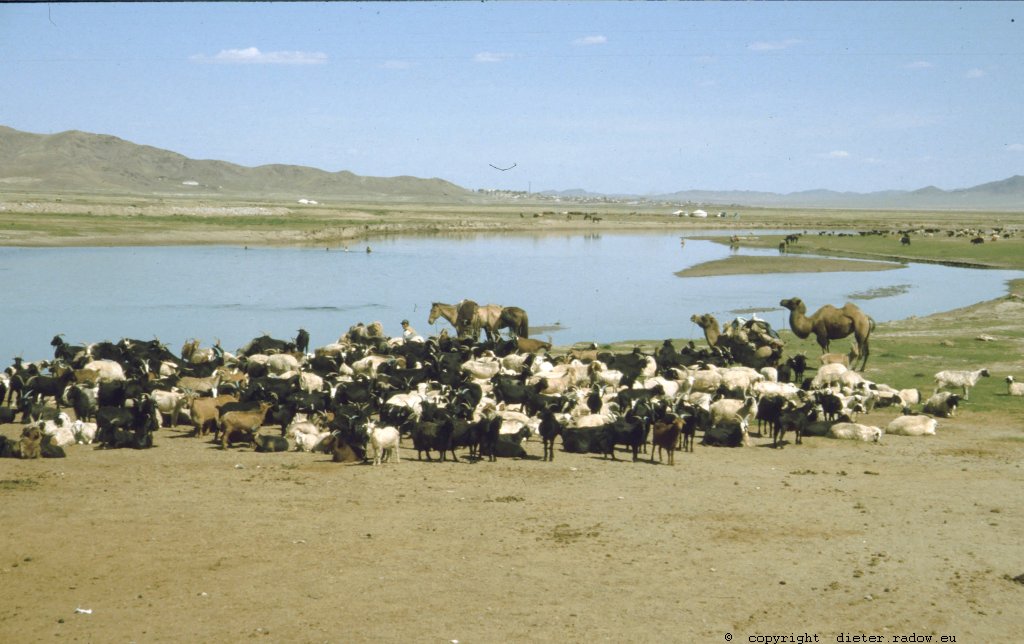
Mongolei 2002 – Schafherde vor Flußquerung – Flüsse sind untypisch für die Steppe; das Wasser kommt aus den angrenzenden Gebirgen
Mongolia 2002 – flock of sheep has to cross the river – Rivers are atypical for steppes. The water comes from mountains outside.

Mongolei 2002 – Schafe und Rinder an Wasserstelle. Der Hirte hat hier vorübergehend eine Jurte in der Steppe aufgestellt.
Mongolia 2002 – flocks of sheep and cattle at a waterplace. There the herdsman has piched a jurt in the steppe

Mongolia 2002 tents of steppe-nomadas Even with nomad electricity° ° ° Mongolei 2002 Zelte von Steppen-Nomaden, sodar mit nomadischer-Elektrizitäts-Erzeugung
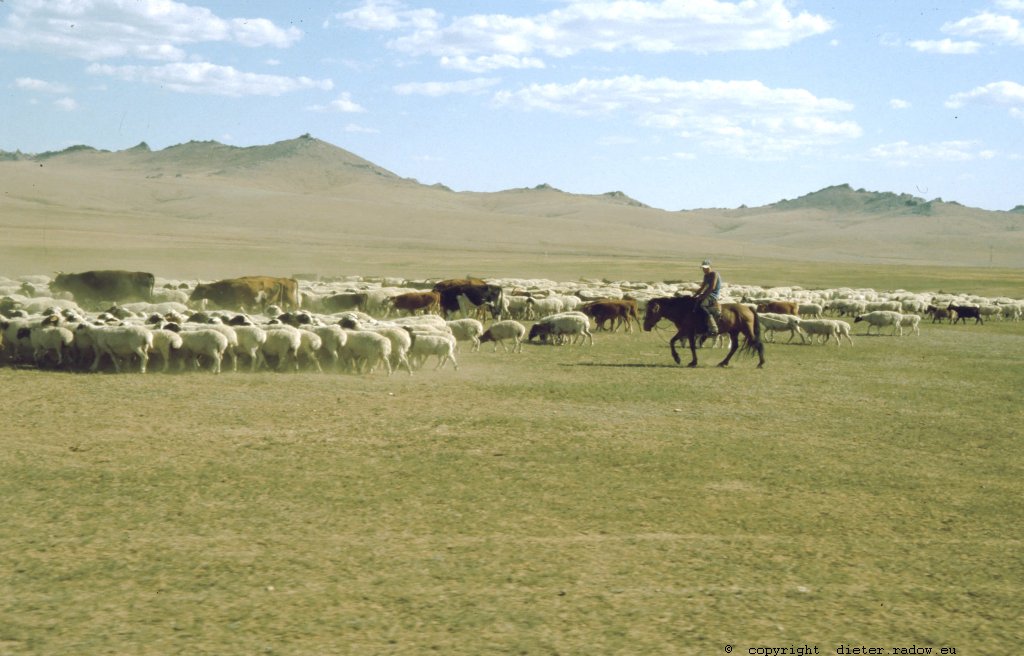
Mongolei 2002 – Steppenhirte zu Pferde bei Schaf-Herde
Mongolia 2002 – steppe-herdsmen on horseback with shepherd and some cows

Mongolei 2002 – Steppenhirten zu Pferde bei Rinder-Herde
Mongolia 2002 – steppe-herdsmen on horseback with cattle-herd

Mongolei 2002 – Steppenhirte zu Pferde bei Rinder-Herde
Mongolia 2002 – steppe-herdsmen on horseback with cattle-herd

Mongolei 2002 – Steppenhirte zu Pferde mit Pferde-Herde in freier Hütung
Mongolia 2002 – steppe-herdsmen on horseback with horse-herd in free guardiance

Mongolei 2002 – das zweihöckrige Kamel in der Steppe
Mongolia 2002 – the two-humped camel in the Mongolian steppe

Mongolei 2002 – Hier wurden in der Sowjetzeit die Nomaden der mongolischen Steppe zwangsangesiedelt. Das Nomadentum paßte nicht zu der Sowjet-Ideologie von Kollektivismus
Mongolia 2002 – in the Sovjet-time the nomads of the Mongolian steppe have been forced to settle here. Nomadis didn`t suit to the Sovjet system of collectivism.

Mongolei 2002 – Fluß-Meander in Steppe im Altai Gebirge
Mongolia 2002 – river from Altai-montains meanderings in the Mongolian steppe

Mongolei 2002 – Die Weiter der mongolischen Steppen
Mongolia 2002 – the expanse of the Mongolian stppes

Mongolei 2002 – Steppe im Übergangsgebiet zur Wüste Gobi
Mongolia 2002 – steppe in the transtion area to the Gobi-Dessert

Mongolei 2002 – 4 Kamele warten auf ihren Einsatz
Mongolia 2002 – waiting to go into action through steppes and desserts

Mongolei 2002 – Zelte der Steppen-Nomaden – Das Nomadentum war zu Sowjet-Zeiten völlig abgeschafft und durch Kolchosen ersetzt. Es erfreut sich jetzt wieder großer Beliebtrheit, weil es den Traditionen und dem Freiheitssinn der Mongolen entprcht und recht profitabel ist.
Mongolia 2002 – tents of steppe-nomads. The nomadism, abolished during Sowjet-times, is now again very popular in Mongolia; it suites to freedom-loving and traditions of the Mongolians and is rather profitable.
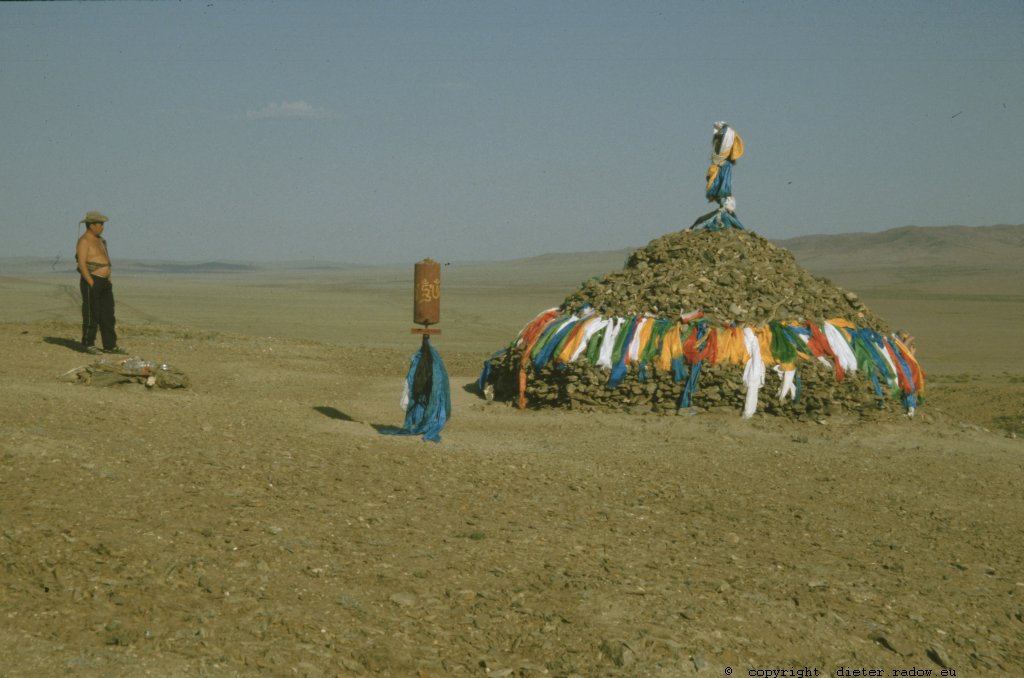
Mongolei 2002 – einfache Stupa und Gebetsmühle in der mongolischen Steppe
Mongolia 2002 – plain Stupa and prayer-wheel in the Mongolian steppe
AFRIKA – AFRICA
TANSANIA – TANSANIA

Tansania 1987 – die Savannen in den Tropen werden geografisch wegen anderer Klimabedingungen nicht zu den Steppen gerechnet
Tanzania 1987 – the savannahs in ther tropics are no steppes in geograhical sense, because of other climate-conditions
TUNESIEN – TUNISIA
ÄTIOPIEN – ETIOPIA

Äthiopien 1997 – die Savannen in den Tropen werden geografisch wegen anderer Klimabedingungen und anderer vegetation nicht zu den Steppen gerechnet
Ethiopia 1997 – the savannahs in the tropics are no steppes in geograhical sense, because of other climate-conditions and different vegetation
SÜDAMERIKA – SOUTH AMERICA
PATAGONIEN – PATAGONIA

BOLIVIEN – BOLIVIA










